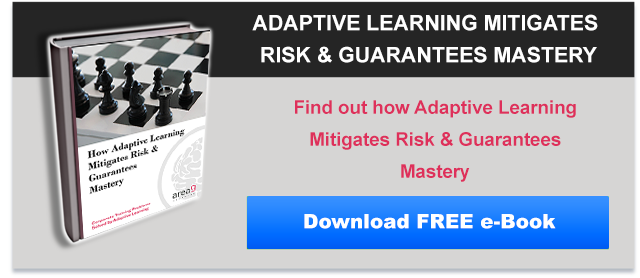Learning and development training will always play a key role in a risk mitigation plan. In high stakes industries like healthcare or banking, and in industries that require important complex skills like aviation, training is a critical tool to mitigate risk.
Every industry that requires a risk mitigation plan probably uses technology to implement it. But while it helps to use technology, like e-learning, in training, here’s why Adaptive Learning is better.
What Your Risk Mitigation Plan Looks Like on Adaptive Learning
- Risk Mitigation in Real Time: Adaptive Learning allows instructional designers to update learning content in real time. As mitigation options and strategies evolve, using an agile development method helps designers get risk mitigation plan updates to learners faster. Unlike with other types of e-learning, which may also offer agile e-learning development, Adaptive Learning allows learners to access those updates without having to review the learning content they’ve already mastered.
- Risk Mitigation Without Redundant Training: The Adaptive Learning system personalizes to individual learners, using self-assessment to understand learners’ knowledge gaps, skills, and level of understanding. When designers add new learning content, in real time, the Adaptive Learning system knows which learners need to see those updates to mitigate risks in their own jobs.
- Risk Mitigation Just in Time: We’ve espoused the benefits of “Just in Case” training before. But in learning and development that mitigates risk, “Just in Time” training has many benefits for the learner and the business. Instead of asking operations engineers or airplane mechanics to carry around binders full of training and reference material, adaptive resources can be accessed on any mobile device; a wi-fi connection is only needed occasionally to download a new course or sync results exactly when your team needs it.
- Risk Mitigation That Saves Time (and Money): As mentioned above, Adaptive Learning
personalizes on an individual level. When learners no longer have to review learning content they’ve already mastered, they’re able to get through their training up to 50% faster with Adaptive Learning - but they can still reliably apply the principles and strategies of a risk mitigation plan because Adaptive Learning guarantees mastery.
Implement an Adaptive Risk Mitigation Plan
Download this infographic to discover two ways Adaptive Learning helps businesses mitigate risk.






